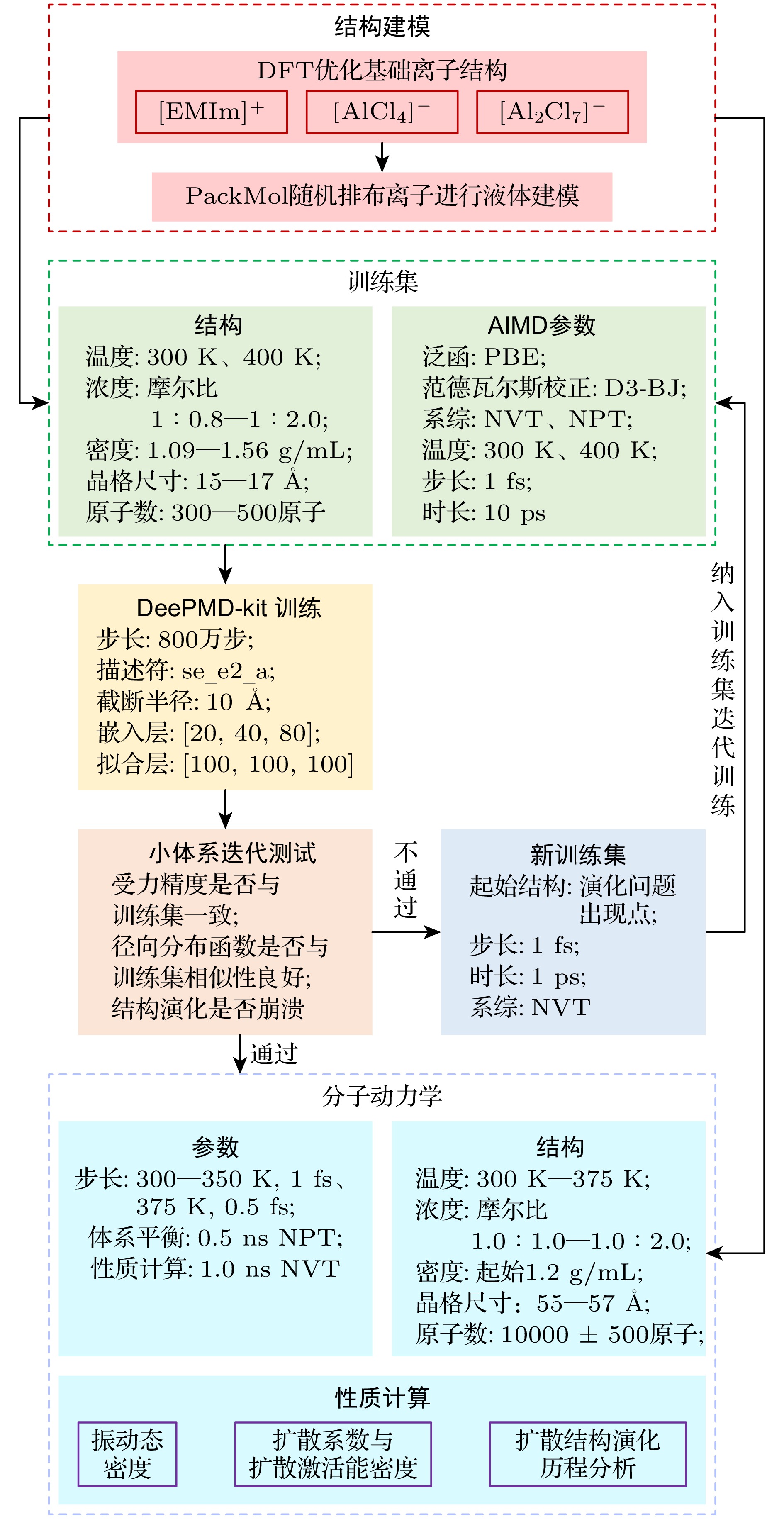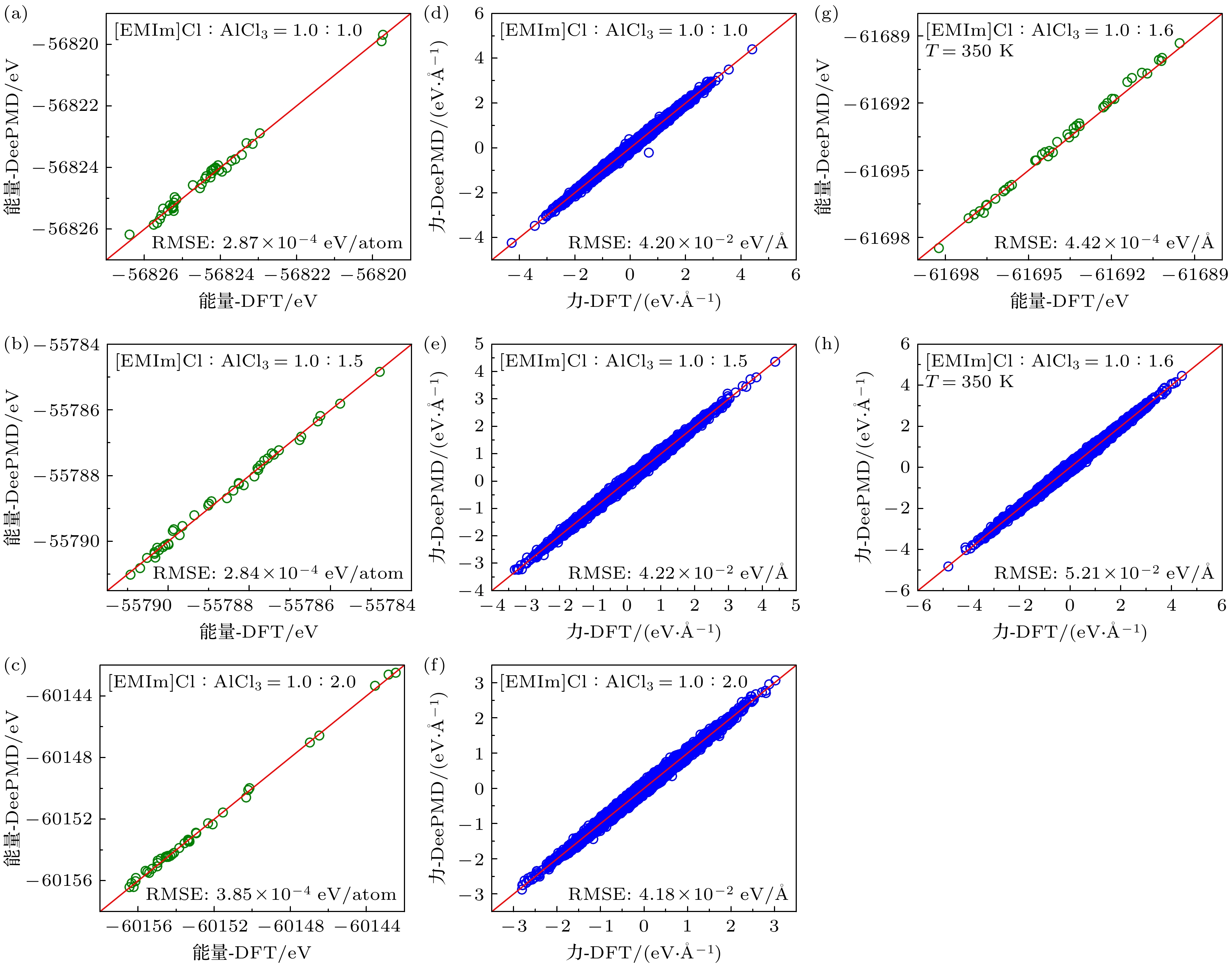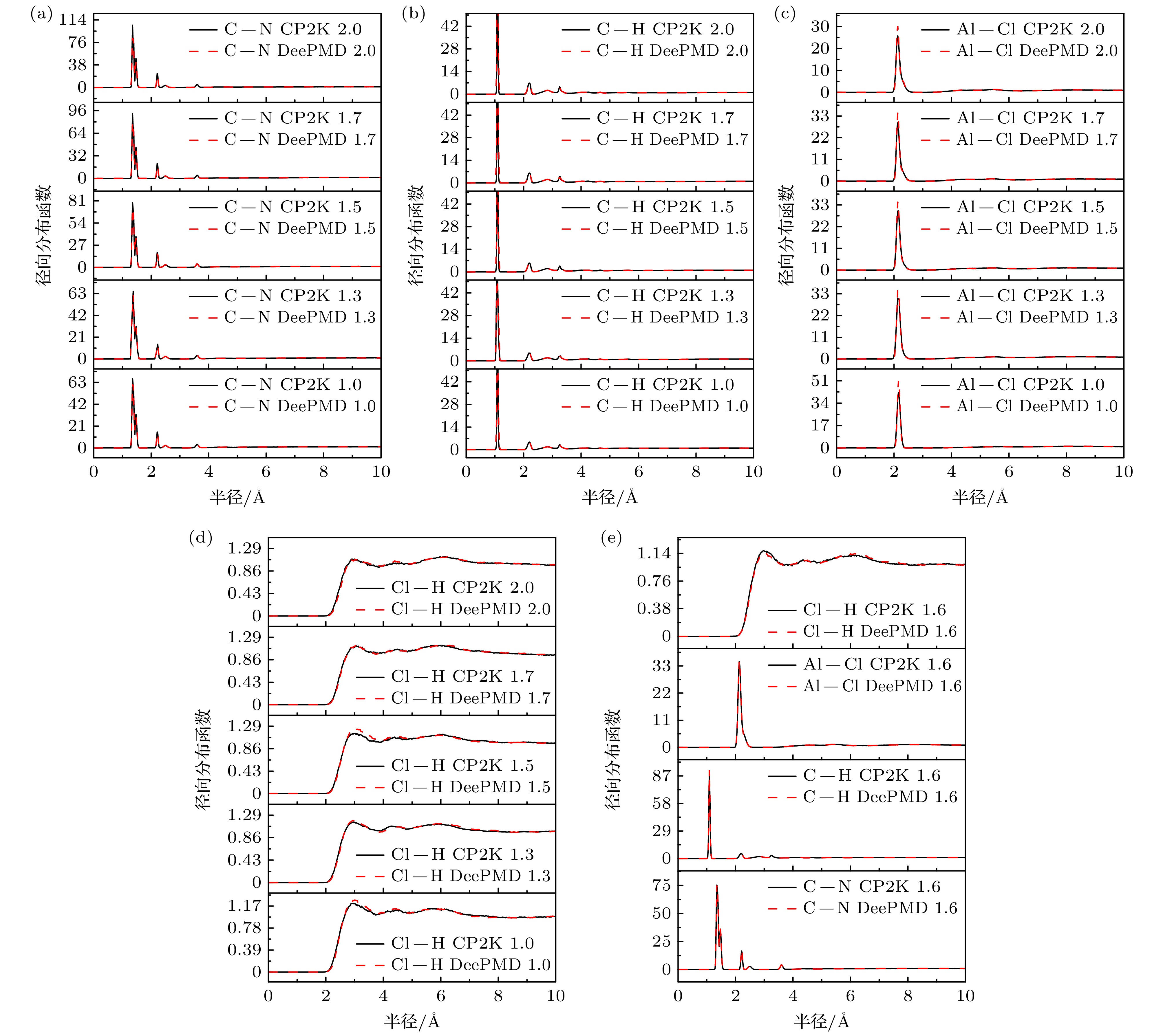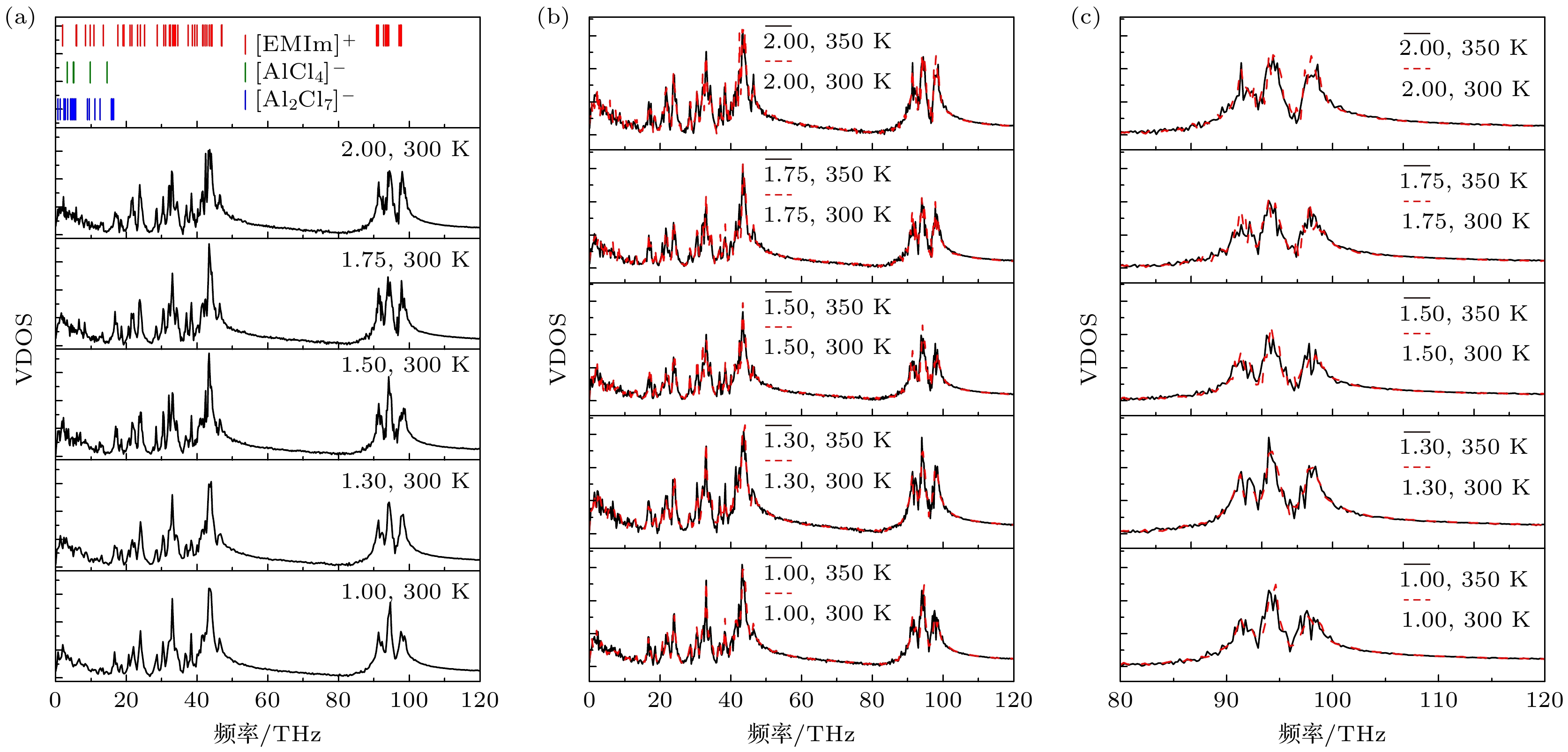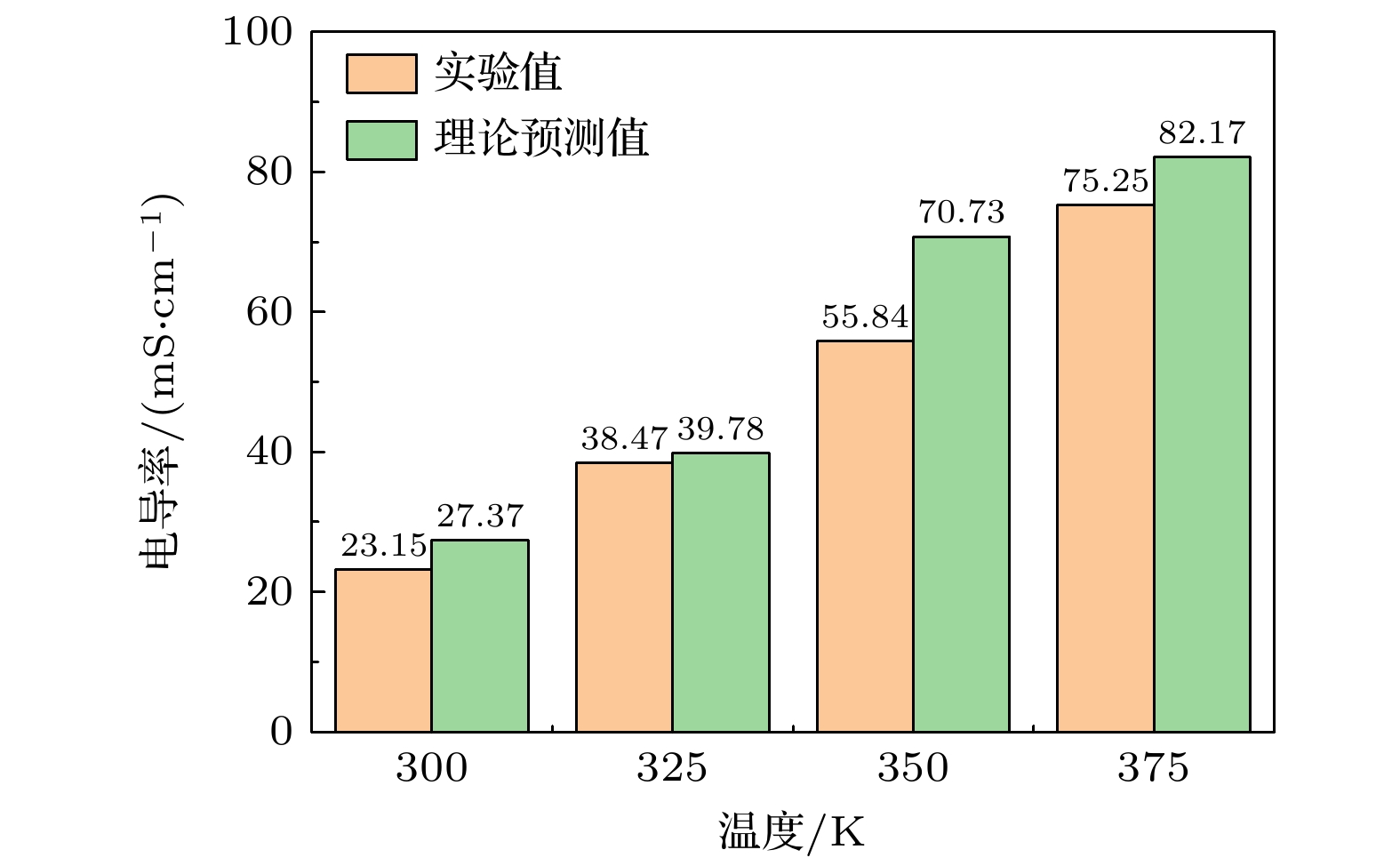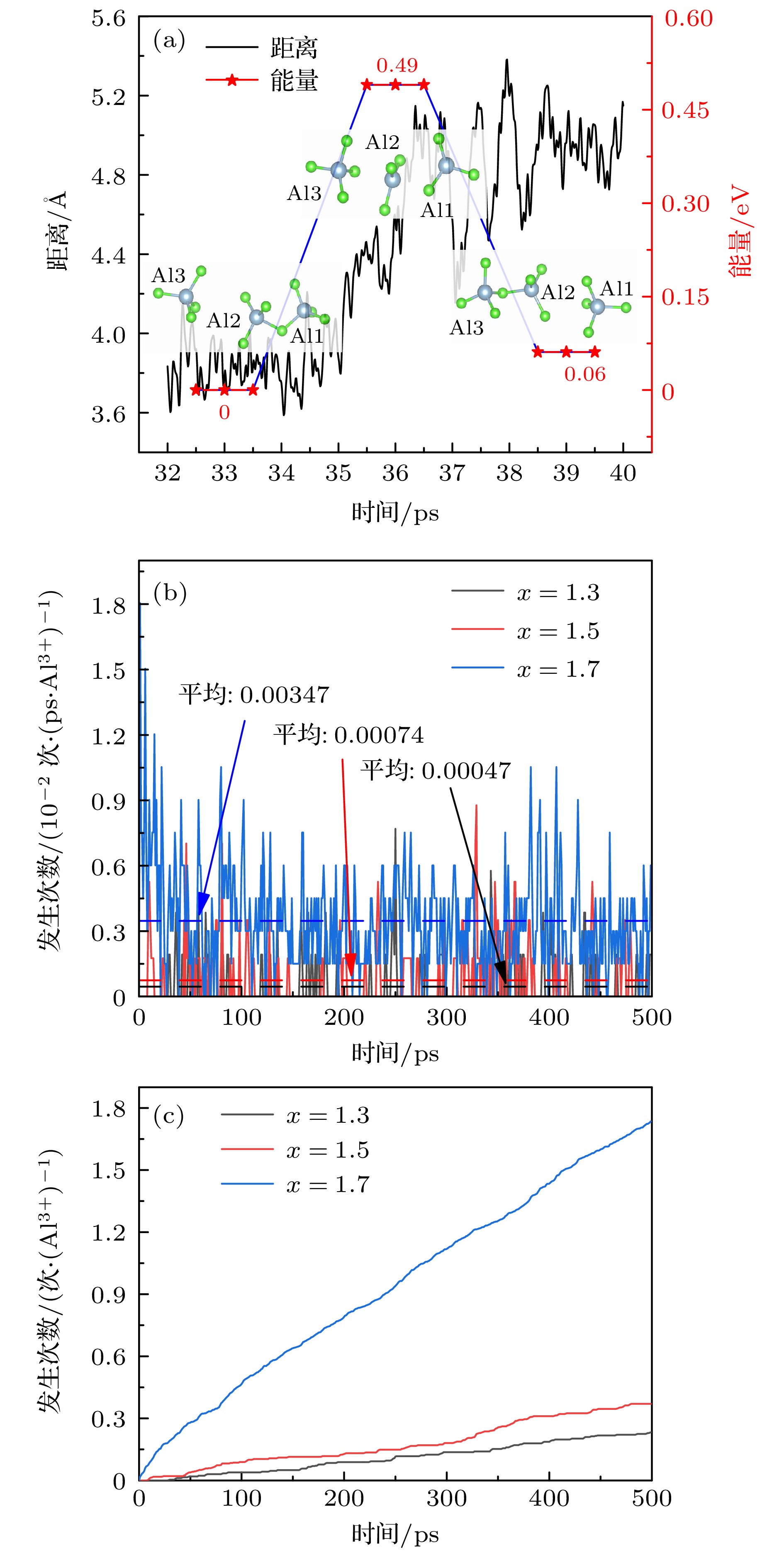-
[EMIm]+Cl–+AlCl3离子液体是一种在铝离子电池中具有突出应用前景的电解液. 由于该离子液体中存在的可迁移离子种类多样(Al3+, AlCl3, [AlCl4]–和[Al2Cl7]–), 而且迁移离子类型之间存在实验研究尚未完全明晰的转换反应过程, 这导致其离子迁移机制复杂且离子扩散动力学过程缓慢, 难以通过常规的基于第一性原理分子动力学的方法实现具有显著统计意义的扩散动力学过程模拟. 本文建立了不同浓度的[EMIm]+Cl–+AlCl3离子液体原子尺度结构模型, 并基于第一性原理分子动力学模拟和主动学习方法构建了训练集和测试集, 实现了高精度的深度学习神经网络原子间势函数的拟合, 其拟合能量和原子受力误差分别为5×10–4 eV/atom和5×10–2 eV/Å. 进一步通过比较深度学习势与第一性原理分子动力学模拟计算得到的[EMIm]+Cl–+AlCl3离子液体径向分布函数和振动谱密度函数, 佐证了机器学习势进行分子动力学计算的可靠性. 最后, 基于深度学习势函数的分子动力学开展了针对包含上万原子体系不同浓度比例的[EMIm]+Cl–+AlCl3离子液体纳秒级别的扩散动力性质的研究, 预测显示300 K下该系列离子液体中Al3+扩散系数基本保持在4×10–7 cm2/s. 基于深度学习势分子动力学轨迹明确了Al3+的两种主要扩散机制: 其一为[AlCl4]–和[Al2Cl7]–在不同溶剂壳层结构的迁移机制; 其二为AlCl3分子通过电解液中[Al2Cl7]–与 [AlCl4]–之间传递AlCl3互相转换实现长程输运的过程. 本文对Al离子电池离子液体电解液的Al3+传输机理进行了更加深入的阐释, 并进一步推动了机器学习势在模拟具有复杂分子结构和扩散动力学反应机制的电解液领域应用.The [EMIm]+Cl–+AlCl3 ion liquid is a promising prototype electrolyte for aluminum-ion batteries (AIBs). Its ionic transport behavior involves multiple mobile species (Al3+, AlCl3, [AlCl4]– and [Al2Cl7]–), with ion migration mechanisms and conversion reactions among these species unsolved experimentally. This complexity results in heterogeneous ion migration mechanisms and sluggish diffusion kinetics, which cannot be accurately and reliably captured by the traditional first-principles molecular dynamics (FPMD) simulations within the very limited time duration (tens of ps) and relatively small modelling structure (less than 103 atoms). The classic molecular dynamics simulations based on various force fields are also scarce for studying and predicting the atomic structure evolution and ion diffusion dynamics of the complex electrolyte system such as ion liquids. In this work, a deep neural network interatomic potential (DP-potential) is developed through machine learning techniques, combining first-principles accuracy with classical molecular dynamics efficiency, to systematically investigate various chemical and physical properties for [EMIm]+Cl–+AlCl3 ion-liquid at finite temperatures. Training and validating of DP potential for [EMIm]+Cl–+AlCl3 ion liquid are implemented with a two-stage protocol, including the primary training stage and the refining stage. Before initiating the two training stages, a series of first-principles molecular dynamics (FPMD) simulations is performed for [EMIm]+Cl–+AlCl3 ion liquids with different molar ratios (1.0, 1.3, 1.5, 1.7 and 2.0) and equilibrium densities (1.09—1.56 g/cm3) at finite temperatures (300 K and 400 K), resulting in a highly diverse training datasets spanning a board range of chemical compositions and densities during the primary training stage for DP potential. Then, the trained DP-potential is employed to conduct long-timescale classic molecular dynamics simulations by using LAMMPS program for the [EMIm]+Cl–+AlCl3 ion liquids to produce the atomic configurations that either show significant errors in the calculated atomic forces and total energies or exhibit the unusual atomic evolution before crashing. Those highly extrapolated atomic configurations are merged with the initial training datasets to reoptimize the DP potential in the second refining stage. Through this two-stage training approach, a deep learning neural network interatomic potential with high accuracy is successfully constructed, achieving an energy prediction error of 5×10–4 eV/atom and a force prediction error of 5×10–2 eV/Å. The reliability of the finally obtained machine learning potential is further validated through a systematic comparison of radial distribution functions (RDF) for some representative atomic pairs such as C—N, C—H, Al—Cl and Cl—H, obtained from both DP-MD and FPMD, demonstrating excellent consistency for the results from the two methods. The DP-MD simulations are systematically carried out to investigate vibrational spectrum and Al3+ diffusion dynamics as well as possible conversion reactions among molecular or ionic species (Al3+, AlCl3, [AlCl4]– and [Al2Cl7]–) in [EMIm]+Cl–+AlCl3 ion liquids within 104 atoms at finite temperatures. From the calculated vibrational density of states (VDOS), it can be seen that the VDOS of [EMIm]+Cl–+AlCl3 ion liquid can be approximated as a simple superposition of the vibrational spectra of individual species ([EMIm]+, [AlCl4]–, and [Al2Cl7]–), with H related vibrational modes dominating above 90 THz and the Al—Cl modes dominating below 20 THz. At 300 K, DP-MD predicts that regardless of the chemical compositions, the diffusion coefficient of Al3+ remains around 4 × 10–7 cm2/s at 300 K and the estimated diffusion activation energy is about 0.20 eV, which is very close to the experimental measurement value (0.15 eV). In addition, the calculated ionic conductivity of [EMIm]+Cl– + AlCl3 at room temperature is 27.37 mS/cm, with a deviation of only 18.2% from the experimental value (23.15 mS/cm). Notably, two different Al3+ diffusion mechanisms are identified in [EMIm]+Cl–+AlCl3 ion liquid: 1) direct migration processes conducted solely by molecular species including [AlCl4]– and [Al2Cl7]–, and 2) the migration of the neutral AlCl3 molecule mediated with two neighboring [AlCl4]– anions through the conversion reaction between [Al2Cl7]– and AlCl3+[AlCl4]– moieties. Furthermore, first-principles calculations on the probable dissociation pathways of [Al2Cl7]– revealed from DP-MD predict a reaction energy barrier height of 0.49 eV for the AlCl3 transferring between two [AlCl4]– anions with an increased reaction probability from 0.00047 events/(ps·Al3+) at 1∶1.3 molar ratio to 0.00347 events/(ps·Al3+) at 1∶1.75 molar ratio. Overall, a highly efficient and reliable workflow to train and validate the deep neural network interatomic potential for complex electrolyte system is successfully proposed, such as [EMIm]+Cl–+AlCl3 ion liquids, thus providing a more comprehensive investigation of Al3+ transport mechanisms in ionic liquid electrolytes for aluminum-ion batteries. In conclusion, this work can further advance the application of machine learning-based potentials in simulating electrolyte systems characterized by complex molecular architectures and sluggish diffusion dynamics.
[1] Das A, Balakrishnan N T M, Sreeram P, Fatima M J J, Joyner J D, Thakur V K, Pullanchiyodan A, Ahn J, Raghavan P 2024 Coordin. Chem. Rev. 502 215593
 Google Scholar
Google Scholar
[2] Taghavi-Kahagh A, Roghani-Mamaqani H, Salami-Kalajahi M 2024 J. Energy Chem. 90 77
 Google Scholar
Google Scholar
[3] Muoz-Torrero D, Jesús Palma, Marcilla R, Ventosa 2019 Dalton T. 48 9906
 Google Scholar
Google Scholar
[4] Liu H L, Wang H Y, Jing Z A, Wu K, Cheng Y H, Xiao B 2020 J. Phys. Chem. C 124 25769
 Google Scholar
Google Scholar
[5] Stephanie R, Park C Y, Shinde P A, Alhajri E, Chodankar N R, Park T J 2024 Energy Storage Mater. 68 103336
 Google Scholar
Google Scholar
[6] Manna S S, Bhauriyal P, Pathak B 2020 Mater. Adv. 1 1354
 Google Scholar
Google Scholar
[7] Yan C S, Lv C D, Wang L G, Cui W, Zhang L Y, Dinh K N, Tan H T, Wu C, Wu T P, Ren Y, Chen J Q, Liu Z, Srinivasan M, Rui X H, Yan Q Y, Yu G H 2020 J. Am. Chem. Soc. 142 15295
 Google Scholar
Google Scholar
[8] Lin M C, Gong M, Lu B G, Wu Y P, Wang D Y, Guan M Y, Angell M, Chen C X, Yang J, Hwang B J, Dai H J 2015 Nature 520 324
 Google Scholar
Google Scholar
[9] Elterman V A, Borozdin A V, Druzhinin K D, Il’ina E A, Shevelin P Y, Yolshina L A 2024 J. Mol. Liq. 394 123702
 Google Scholar
Google Scholar
[10] Lv Z C, Han M, Sun J H, Hou L X, Chen H, Li Y X, Lin M C 2019 J. Power Sources 418 233
 Google Scholar
Google Scholar
[11] Ng K L, Malik M, Buch E, Glossmann T, Hintennach A, Azimi G 2019 Electrochim. Acta 327 135031
 Google Scholar
Google Scholar
[12] Lv T S, Suo L M 2021 Curr. Opin. Electrochem. 29 100818
 Google Scholar
Google Scholar
[13] Gao T, Li X G, Wang X W, Hu J K, Han F D, Fan X L, Suo L M, Pearse A J, Lee S B, Rubloff G W, Gaskell K J, Noked M, Wang C S 2016 Angew. Chem. 128 10052
 Google Scholar
Google Scholar
[14] Lei H P, Wang M Y, Tu J G, Jiao S Q 2019 Sustain. Energ. Fuels 3 2717
 Google Scholar
Google Scholar
[15] Huo X G, Zhang B, Li J L, Wang X X, Qin T, Zhang Y, Kang F Y 2021 ACS Appl. Mater. Interfaces 13 11822
 Google Scholar
Google Scholar
[16] Ahmed A N, Nahian M K, Reddy R G 2024 Metall. Mater. Trans. B 55 1754
 Google Scholar
Google Scholar
[17] Elterman V A, Shevelin P Y, Yolshina L A, Borozdin A V 2022 J. Mol. Liq. 364 120061
 Google Scholar
Google Scholar
[18] Liu H L, Zeng C, Jing Z A, Wu K, Cheng Y H, Xiao B 2025 Nanoscale 17 5375
 Google Scholar
Google Scholar
[19] Li J H, Zeng F S, El-Demellawi J K, Lin Q C, Xi S K, Wu J W, Tang J C, Zhang X X, Liu X J, Tu S B 2022 ACS Appl. Mater. Interfaces 14 45254
 Google Scholar
Google Scholar
[20] Kosar M, Taimoory S M, Diesenhaus O, Trant J F 2023 J. Chem. Phys. 159 144503
 Google Scholar
Google Scholar
[21] Senftle T P, Hong S, Islam M M 2016 npj Comput. Mater. 2 15011
 Google Scholar
Google Scholar
[22] Jain A 2024 Curr. Opin. Solid St. M. 33 101189
 Google Scholar
Google Scholar
[23] Poltavsky I, Tkatchenko A 2021 J. Phys. Chem. Lett. 12 6551
 Google Scholar
Google Scholar
[24] Song R, Liu X M, Wang H B, Lü H, Song X Y 2024 Acta Phys. Sin. 73 126201 [宋睿, 刘雪梅, 王海滨, 吕皓, 宋晓艳 2024 物理学报 73 126201]
 Google Scholar
Google Scholar
Song R, Liu X M, Wang H B, Lü H, Song X Y 2024 Acta Phys. Sin. 73 126201
 Google Scholar
Google Scholar
[25] Botu V, Batra R, Chapman J, Ramprasad R 2017 J. Phys. Chem. C 121 511
 Google Scholar
Google Scholar
[26] Wang P J, Fan J Y, Su Y, Zhao J J 2020 Acta Phys. Sin. 69 238702 [王鹏举, 范俊宇, 苏艳, 赵纪军 2020 物理学报 69 238702]
 Google Scholar
Google Scholar
Wang P J, Fan J Y, Su Y, Zhao J J 2020 Acta Phys. Sin. 69 238702
 Google Scholar
Google Scholar
[27] Ouyang X J, Zhang Y X, Wang Z L, Zhang F, Chen W J, Zhuang Y, Jie X, Liu L J, Wang D W 2024 Acta Phys. Sin. 73 086301 [欧阳鑫健, 张岩星, 王之龙, 张锋, 陈韦嘉, 庄园, 揭晓, 刘来君, 王大威 2024 物理学报 73 086301]
 Google Scholar
Google Scholar
Ouyang X J, Zhang Y X, Wang Z L, Zhang F, Chen W J, Zhuang Y, Jie X, Liu L J, Wang D W 2024 Acta Phys. Sin. 73 086301
 Google Scholar
Google Scholar
[28] Li Z Q, Tan X Y, Duan X L, Zhang J Y, Yang J Y 2022 Acta Phys. Sin. 71 247803 [李志强, 谭晓瑜, 段忻磊, 张敬义, 杨家跃 2022 物理学报 71 247803]
 Google Scholar
Google Scholar
Li Z Q, Tan X Y, Duan X L, Zhang J Y, Yang J Y 2022 Acta Phys. Sin. 71 247803
 Google Scholar
Google Scholar
[29] Zhu D, Li Sheng, Hu T P, Chen S, Shi M C, Hua H M, Yang K, Wang J L, Tang Y P, He X M, Xu H, et al. 2024 J. Phys. Chem. Lett. 15 4024
 Google Scholar
Google Scholar
[30] Zheng Z Y, Zhou J, Zhu Y S 2024 Chem. Soc. Rev. 53 3134
 Google Scholar
Google Scholar
[31] Wu M W, Wei Z, Zhao Y, He Q 2025 Nanomaterials 15 22
[32] Gong S, Zhang Y M, Mu Z L, Pu Z C, Wang H Y, Han X, Yu Z A, Chen M Y, Zhang T Z, Wang Z, Chen L F, Yang Z Z, Wu X J, Shi S C, Gao W H, Yan W, Xiang L 2025 Nat. mach. Intell. 7 543
 Google Scholar
Google Scholar
[33] Thomas D, Kühne T D, Iannuzzi M, Mauro Del Ben M D, Rybkin V V, Seewalk P, Stein F, Laino T, Khaliullin R Z, Scheütt O, Schiffmann F, Golze D, Wilhelm J, Chulkov S, Bani-Hashemian M H, Weber V, Borštnik U, Taillefumier M, Jakobovits A S, Lazzaro A, Pabst H, Müller T, Schade R, Guidon M, Andermatt S, Holmberg N, Schenter G K, Hehn A, Bussy A, Belleflamme F, Tabacchi G, Glöß A, Lass M, Bethune I, Mundy C J, Plessl C, Watkins M, VandeVondele J, Krack M, Hutter J 2020 J. Chem. Phys. 152 194103
 Google Scholar
Google Scholar
[34] Zeng J Z, Zhang D, Peng A Y, Zhang X Y, He S S, Wang Y, Liu X Z J, Bi H R, Li Y F, Cai C, Zhang C Q, Du Y M, Zhu J X, Mo P H, Huang Z T, Zeng Q Y, Shi S C, Qin X J, Yu Z X, Luo C X, Ding Y, Liu Y P, Shi R S, Wang Z Y, Bore S L, Chang J H, Deng Z, Ding Z H, Han S Y, Jiang W R, Ke G J, Liu Z Q, Lu D H, Muraoka K, Oliaei H, Singh A K, Que H H, Xu W H, Xu Z M C, Zhuang Y B, Dai J Y, Giese T J, Jia W L, Xu B, York D M, Zhang L F, Wang H 2025 J. Chem. Theory Comput. 21 4375
 Google Scholar
Google Scholar
[35] Martínez L, Andrade R, Birgin E G, Martínez J M 2009 J. Comput. Chem. 30 2157
 Google Scholar
Google Scholar
[36] Perdew J P, Burke K, Ernzerhof M 1996 Phys. Rev. Lett. 78 1396
 Google Scholar
Google Scholar
[37] VandeVondele J, Hutter J 2007 J. Chem. Phys. 127 114105
 Google Scholar
Google Scholar
[38] Goedecker S, Teter M, Hutter J 1996 Phys. Rev. B 54 1703
 Google Scholar
Google Scholar
[39] Grimme S, Antony J, Ehrlich S, Krieg H 2010 J. Chem. Phys. 132 154104
 Google Scholar
Google Scholar
[40] Grimme S, Ehrlich S, Goerigk L 2011 J. Comput. Chem. 32 1456
 Google Scholar
Google Scholar
[41] Thompson A P, Aktulga H M, Berger R, Bolintineanu D S, Brown W M, Crozier P S, Veld P J, Kohlmeyer A, Moore S G, Nguyen T D, Shan R, Stevens M J, Tranchida J, Trott C, Plimpton S J 2022 Comput. Phys. Commun. 271 10817
[42] Dickey J M, Paskin A 1969 Phys. Rev. 188 1407
 Google Scholar
Google Scholar
[43] Manz T A 2017 RSC Adv. 7 45552
 Google Scholar
Google Scholar
-
图 1 [EMIm]+Cl–+AlCl3离子液体分子结构模型 (a) 阴阳离子单元分子结构, 其中给出了Al—Cl键键级及每个氯离子所带电荷; (b) 训练集模型; (c) 性质计算采用的分子动力学模型
Fig. 1. Modeling structures of [EMIm]+Cl–+AlCl3 ionic liquid: (a) Basic building blocks of cation and anion where the Al—Cl bond orders and charges on each chloride ion are indicated by numbers; (b) training set models; (c) molecular structures for property calculations using molecular dynamics simulations.
图 3 不同[EMIm]+Cl–∶AlCl3比例时, 机器学习势对能量与力精度RMSE的测试结果, 总能量 (a) 1∶1.0; (b) 1∶1.5; (c) 1∶2.0; (g) 1∶1.6, T = 350 K; 原子受力 (d) 1∶1.0; (e) 1∶1.5; (f) 1∶2.0; (h) 1∶1.6, T = 350 K
Fig. 3. Validation of the trained machine learning potential by means of RMSE for [EMIm]Cl-AlCl3 ion liquids with different molar ratios, total energy: (a) 1∶1.0; (b) 1∶1.5; (c) 1∶2.0; (d) 1∶1.6, T = 350 K; atomic force: (e) 1∶1.0; (f) 1: 1.5; (g) 1∶2.0; (h) 1∶1.6, T = 350 K.
图 4 CP2K及DeePMD分子动力学模拟的在不同的 [EMIm]+Cl–∶AlCl3 = 1∶x (x取值范围为1.0—2.0)比例下代表性原子对的径向分布函数对比 (a) C—N; (b) C—H; (c) Al—Cl; (d) Cl—H; (e)机器学习势预测x = 1.6时的RDF与CP2K计算结果的对比
Fig. 4. Comparison of radial distribution functions via CP2K and DeePMD molecular dynamics simulations for representative atomic pairs in [EMIm]+Cl–∶AlCl3 ionic liquids at 1∶x ratios (1.0 ≤ x ≤ 2.0): (a) C—N; (b) C—H; (c) Al—Cl; (d) Cl—H; (e) comparison of the predicted RDFs using machine learning potential when x = 1.6 with those of profiles obtained from CP2K program.
图 5 DP势分子动力学计算得到的[EMIm]+Cl–+AlCl3离子液体总的VDOS与DFT计算的孤立阴阳离子振动谱的对比 (a) 300 K时的VDOS与阴阳离子振动谱分析对比; (b) 300 K结果与350 K结果对比; (c) 300 K结果与350 K结果在高频部分(> 80 THz)的对比
Fig. 5. VDOS profiles obtained from DP-MD simulations versus vibrational frequencies of the isolated cation and anions in [EMIm]+Cl–+AlCl3 ion-liquid at 1∶1 to 1∶2 molar ratios: (a) VDOS at 300 K; (b) comparison of VDOS profiles at 300 K and 350 K; (c) comparison of VDOS at 300 K and 350 K above 80 THz.
图 6 [EMIm]+Cl–+AlCl3离子液体不同温度及摩尔浓度下的扩散性质 (a) [EMIm]+Cl–∶AlCl3 = 1.0∶1.0时的均方位移; (b) [EMIm]+Cl–∶AlCl3 = 1.0∶1.5时的均方位移; (c) [EMIm]+Cl–∶AlCl3 = 1.0∶2.0时的均方位移; (d) Al3+的扩散系数; (e) [EMIm]+的扩散系数; (f) Al3+和[EMIm]+的扩散激活能
Fig. 6. The diffusion properties of [EMIm]+Cl–+AlCl3 ionic liquids from DP-MD simulations at various temperatures and molar ratios: (a) MSD for the molar ratio of 1.0∶1.0; (b) MSD for the molar ratio of 1.0∶1.5; (c) MSD for the molar ratio of 1.0∶2.0; (d) diffusion coefficients of Al3+; (e) diffusion coefficients of [EMIm]+; (f) diffusion activation energy of Al3+ and [EMIm]+.
图 9 (a) AlCl3通过[Al2Cl7]–+AlCl3转换反应传递扩散过程及对应转换反应能垒; (b), (c) [AlCl4]–与[Al2Cl7]–互相转化反应的瞬态频率(每ps反应发生次数)及累计频率情况(反应发生次数累计)
Fig. 9. (a) Migration mechanism of AlCl3 through the conversion reaction between [Al2Cl7]– and AlCl3, and the corresponding reaction barrier heights; (b), (c) transient frequency (number of reactions per ps) and cumulative conversion rates (cumulative number of reaction occurrences) between [AlCl4]– to [Al2Cl7]–.
表 1 机器学习势训练集初始设置
Table 1. Atomic configurations and computational parameters for obtaining ML potential training data.
摩尔比 原子数 [AlCl4]–/个 [Al2Cl7]–/个 [EMIm]–/个 温度/K 密度/(g·mL–1) 系综 1.0 408 17 0 17 400 1.09 NPT 300 1.09 NPT 300 1.28 NVT 300 1.44 NVT 1.3 376 11 4 15 400 1.21 NPT 300 1.21 NPT 300 1.34 NVT 300 1.52 NVT 1.5 364 7 7 14 400 1.17 NPT 300 1.17 NPT 300 1.36 NVT 300 1.52 NVT 1.7 376 4 10 14 400 1.27 NPT 300 1.27 NPT 300 1.38 NVT 300 1.55 NVT 2.0 364 0 13 13 400 1.30 NPT 300 1.30 NPT 300 1.41 NVT 300 1.56 NVT 表 2 基于机器学习势的分子动力学模拟体系结构设置及参数
Table 2. Initial setups and structural parameters for molecular dynamics simulations using machine learning potential.
摩尔
比原子
数/个起始晶格
大小/Å[EMIm]+/
个[AlCl4]–/
个[Al2Cl7]–/
个1.00 10320 55 430 430 0 1.30 10080 55 400 280 120 1.50 9880 57 380 190 190 1.75 10260 57 380 95 285 2.00 10360 57 370 0 370 -
[1] Das A, Balakrishnan N T M, Sreeram P, Fatima M J J, Joyner J D, Thakur V K, Pullanchiyodan A, Ahn J, Raghavan P 2024 Coordin. Chem. Rev. 502 215593
 Google Scholar
Google Scholar
[2] Taghavi-Kahagh A, Roghani-Mamaqani H, Salami-Kalajahi M 2024 J. Energy Chem. 90 77
 Google Scholar
Google Scholar
[3] Muoz-Torrero D, Jesús Palma, Marcilla R, Ventosa 2019 Dalton T. 48 9906
 Google Scholar
Google Scholar
[4] Liu H L, Wang H Y, Jing Z A, Wu K, Cheng Y H, Xiao B 2020 J. Phys. Chem. C 124 25769
 Google Scholar
Google Scholar
[5] Stephanie R, Park C Y, Shinde P A, Alhajri E, Chodankar N R, Park T J 2024 Energy Storage Mater. 68 103336
 Google Scholar
Google Scholar
[6] Manna S S, Bhauriyal P, Pathak B 2020 Mater. Adv. 1 1354
 Google Scholar
Google Scholar
[7] Yan C S, Lv C D, Wang L G, Cui W, Zhang L Y, Dinh K N, Tan H T, Wu C, Wu T P, Ren Y, Chen J Q, Liu Z, Srinivasan M, Rui X H, Yan Q Y, Yu G H 2020 J. Am. Chem. Soc. 142 15295
 Google Scholar
Google Scholar
[8] Lin M C, Gong M, Lu B G, Wu Y P, Wang D Y, Guan M Y, Angell M, Chen C X, Yang J, Hwang B J, Dai H J 2015 Nature 520 324
 Google Scholar
Google Scholar
[9] Elterman V A, Borozdin A V, Druzhinin K D, Il’ina E A, Shevelin P Y, Yolshina L A 2024 J. Mol. Liq. 394 123702
 Google Scholar
Google Scholar
[10] Lv Z C, Han M, Sun J H, Hou L X, Chen H, Li Y X, Lin M C 2019 J. Power Sources 418 233
 Google Scholar
Google Scholar
[11] Ng K L, Malik M, Buch E, Glossmann T, Hintennach A, Azimi G 2019 Electrochim. Acta 327 135031
 Google Scholar
Google Scholar
[12] Lv T S, Suo L M 2021 Curr. Opin. Electrochem. 29 100818
 Google Scholar
Google Scholar
[13] Gao T, Li X G, Wang X W, Hu J K, Han F D, Fan X L, Suo L M, Pearse A J, Lee S B, Rubloff G W, Gaskell K J, Noked M, Wang C S 2016 Angew. Chem. 128 10052
 Google Scholar
Google Scholar
[14] Lei H P, Wang M Y, Tu J G, Jiao S Q 2019 Sustain. Energ. Fuels 3 2717
 Google Scholar
Google Scholar
[15] Huo X G, Zhang B, Li J L, Wang X X, Qin T, Zhang Y, Kang F Y 2021 ACS Appl. Mater. Interfaces 13 11822
 Google Scholar
Google Scholar
[16] Ahmed A N, Nahian M K, Reddy R G 2024 Metall. Mater. Trans. B 55 1754
 Google Scholar
Google Scholar
[17] Elterman V A, Shevelin P Y, Yolshina L A, Borozdin A V 2022 J. Mol. Liq. 364 120061
 Google Scholar
Google Scholar
[18] Liu H L, Zeng C, Jing Z A, Wu K, Cheng Y H, Xiao B 2025 Nanoscale 17 5375
 Google Scholar
Google Scholar
[19] Li J H, Zeng F S, El-Demellawi J K, Lin Q C, Xi S K, Wu J W, Tang J C, Zhang X X, Liu X J, Tu S B 2022 ACS Appl. Mater. Interfaces 14 45254
 Google Scholar
Google Scholar
[20] Kosar M, Taimoory S M, Diesenhaus O, Trant J F 2023 J. Chem. Phys. 159 144503
 Google Scholar
Google Scholar
[21] Senftle T P, Hong S, Islam M M 2016 npj Comput. Mater. 2 15011
 Google Scholar
Google Scholar
[22] Jain A 2024 Curr. Opin. Solid St. M. 33 101189
 Google Scholar
Google Scholar
[23] Poltavsky I, Tkatchenko A 2021 J. Phys. Chem. Lett. 12 6551
 Google Scholar
Google Scholar
[24] Song R, Liu X M, Wang H B, Lü H, Song X Y 2024 Acta Phys. Sin. 73 126201 [宋睿, 刘雪梅, 王海滨, 吕皓, 宋晓艳 2024 物理学报 73 126201]
 Google Scholar
Google Scholar
Song R, Liu X M, Wang H B, Lü H, Song X Y 2024 Acta Phys. Sin. 73 126201
 Google Scholar
Google Scholar
[25] Botu V, Batra R, Chapman J, Ramprasad R 2017 J. Phys. Chem. C 121 511
 Google Scholar
Google Scholar
[26] Wang P J, Fan J Y, Su Y, Zhao J J 2020 Acta Phys. Sin. 69 238702 [王鹏举, 范俊宇, 苏艳, 赵纪军 2020 物理学报 69 238702]
 Google Scholar
Google Scholar
Wang P J, Fan J Y, Su Y, Zhao J J 2020 Acta Phys. Sin. 69 238702
 Google Scholar
Google Scholar
[27] Ouyang X J, Zhang Y X, Wang Z L, Zhang F, Chen W J, Zhuang Y, Jie X, Liu L J, Wang D W 2024 Acta Phys. Sin. 73 086301 [欧阳鑫健, 张岩星, 王之龙, 张锋, 陈韦嘉, 庄园, 揭晓, 刘来君, 王大威 2024 物理学报 73 086301]
 Google Scholar
Google Scholar
Ouyang X J, Zhang Y X, Wang Z L, Zhang F, Chen W J, Zhuang Y, Jie X, Liu L J, Wang D W 2024 Acta Phys. Sin. 73 086301
 Google Scholar
Google Scholar
[28] Li Z Q, Tan X Y, Duan X L, Zhang J Y, Yang J Y 2022 Acta Phys. Sin. 71 247803 [李志强, 谭晓瑜, 段忻磊, 张敬义, 杨家跃 2022 物理学报 71 247803]
 Google Scholar
Google Scholar
Li Z Q, Tan X Y, Duan X L, Zhang J Y, Yang J Y 2022 Acta Phys. Sin. 71 247803
 Google Scholar
Google Scholar
[29] Zhu D, Li Sheng, Hu T P, Chen S, Shi M C, Hua H M, Yang K, Wang J L, Tang Y P, He X M, Xu H, et al. 2024 J. Phys. Chem. Lett. 15 4024
 Google Scholar
Google Scholar
[30] Zheng Z Y, Zhou J, Zhu Y S 2024 Chem. Soc. Rev. 53 3134
 Google Scholar
Google Scholar
[31] Wu M W, Wei Z, Zhao Y, He Q 2025 Nanomaterials 15 22
[32] Gong S, Zhang Y M, Mu Z L, Pu Z C, Wang H Y, Han X, Yu Z A, Chen M Y, Zhang T Z, Wang Z, Chen L F, Yang Z Z, Wu X J, Shi S C, Gao W H, Yan W, Xiang L 2025 Nat. mach. Intell. 7 543
 Google Scholar
Google Scholar
[33] Thomas D, Kühne T D, Iannuzzi M, Mauro Del Ben M D, Rybkin V V, Seewalk P, Stein F, Laino T, Khaliullin R Z, Scheütt O, Schiffmann F, Golze D, Wilhelm J, Chulkov S, Bani-Hashemian M H, Weber V, Borštnik U, Taillefumier M, Jakobovits A S, Lazzaro A, Pabst H, Müller T, Schade R, Guidon M, Andermatt S, Holmberg N, Schenter G K, Hehn A, Bussy A, Belleflamme F, Tabacchi G, Glöß A, Lass M, Bethune I, Mundy C J, Plessl C, Watkins M, VandeVondele J, Krack M, Hutter J 2020 J. Chem. Phys. 152 194103
 Google Scholar
Google Scholar
[34] Zeng J Z, Zhang D, Peng A Y, Zhang X Y, He S S, Wang Y, Liu X Z J, Bi H R, Li Y F, Cai C, Zhang C Q, Du Y M, Zhu J X, Mo P H, Huang Z T, Zeng Q Y, Shi S C, Qin X J, Yu Z X, Luo C X, Ding Y, Liu Y P, Shi R S, Wang Z Y, Bore S L, Chang J H, Deng Z, Ding Z H, Han S Y, Jiang W R, Ke G J, Liu Z Q, Lu D H, Muraoka K, Oliaei H, Singh A K, Que H H, Xu W H, Xu Z M C, Zhuang Y B, Dai J Y, Giese T J, Jia W L, Xu B, York D M, Zhang L F, Wang H 2025 J. Chem. Theory Comput. 21 4375
 Google Scholar
Google Scholar
[35] Martínez L, Andrade R, Birgin E G, Martínez J M 2009 J. Comput. Chem. 30 2157
 Google Scholar
Google Scholar
[36] Perdew J P, Burke K, Ernzerhof M 1996 Phys. Rev. Lett. 78 1396
 Google Scholar
Google Scholar
[37] VandeVondele J, Hutter J 2007 J. Chem. Phys. 127 114105
 Google Scholar
Google Scholar
[38] Goedecker S, Teter M, Hutter J 1996 Phys. Rev. B 54 1703
 Google Scholar
Google Scholar
[39] Grimme S, Antony J, Ehrlich S, Krieg H 2010 J. Chem. Phys. 132 154104
 Google Scholar
Google Scholar
[40] Grimme S, Ehrlich S, Goerigk L 2011 J. Comput. Chem. 32 1456
 Google Scholar
Google Scholar
[41] Thompson A P, Aktulga H M, Berger R, Bolintineanu D S, Brown W M, Crozier P S, Veld P J, Kohlmeyer A, Moore S G, Nguyen T D, Shan R, Stevens M J, Tranchida J, Trott C, Plimpton S J 2022 Comput. Phys. Commun. 271 10817
[42] Dickey J M, Paskin A 1969 Phys. Rev. 188 1407
 Google Scholar
Google Scholar
[43] Manz T A 2017 RSC Adv. 7 45552
 Google Scholar
Google Scholar
计量
- 文章访问数: 2044
- PDF下载量: 43
- 被引次数: 0













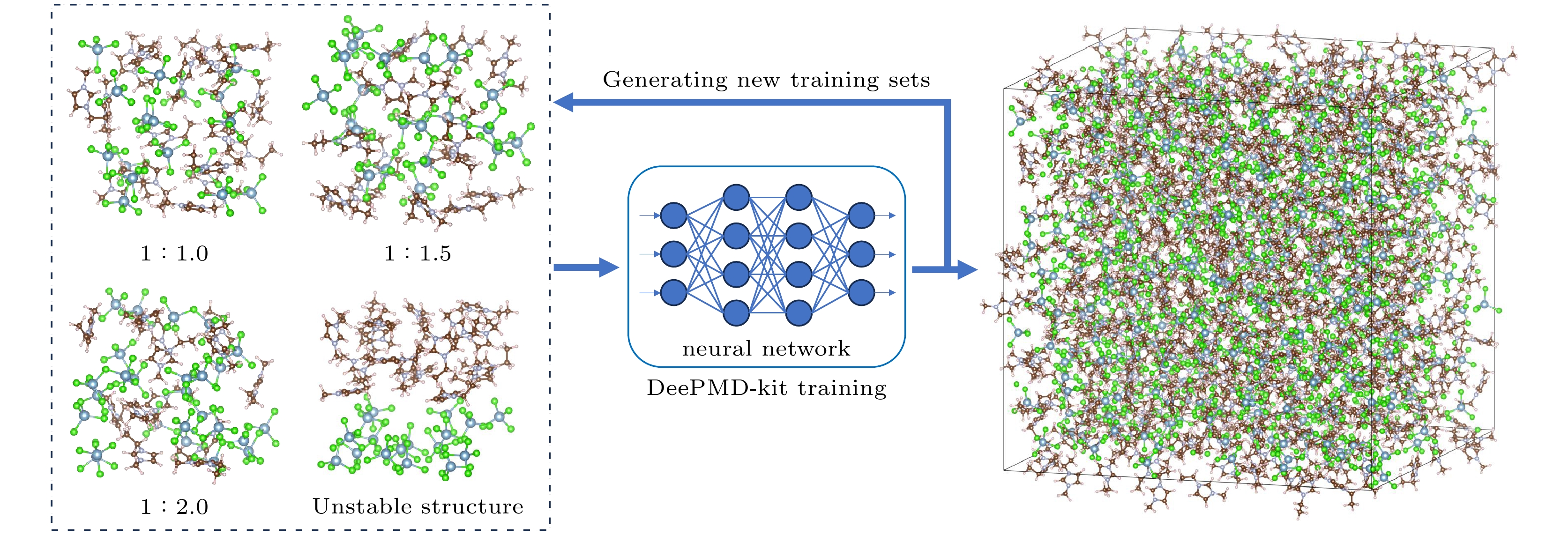
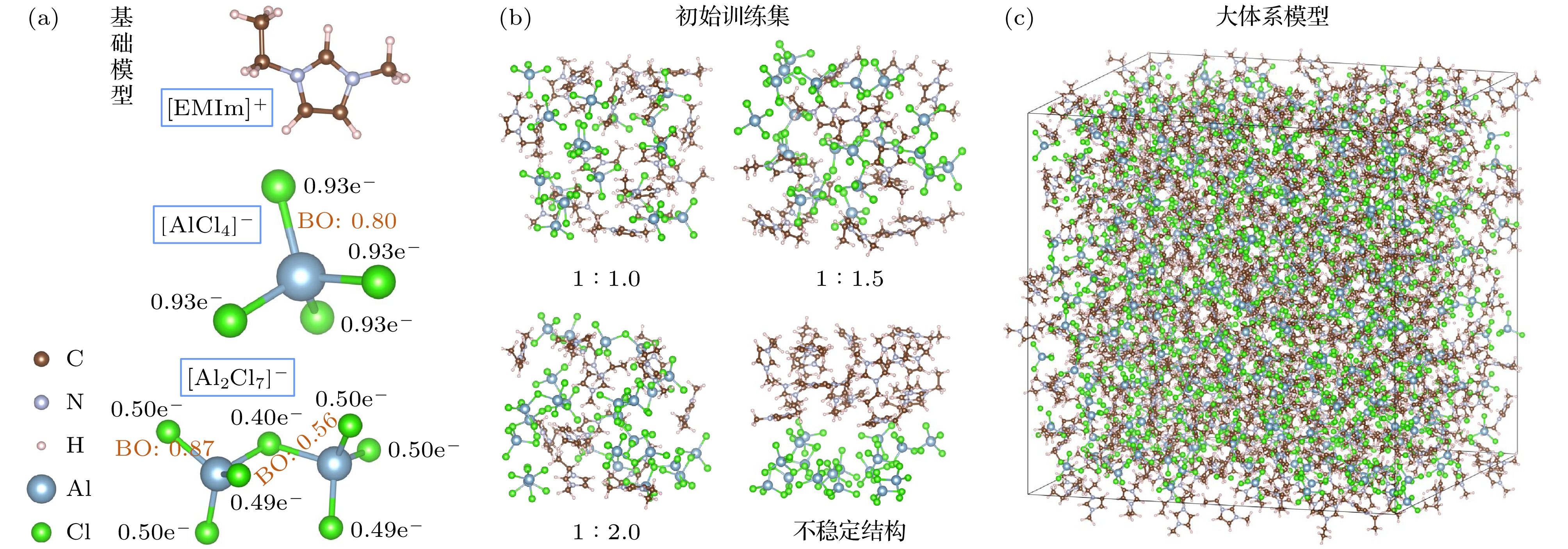
 下载:
下载:
